Volleyball drills for technique passing / defense / reception
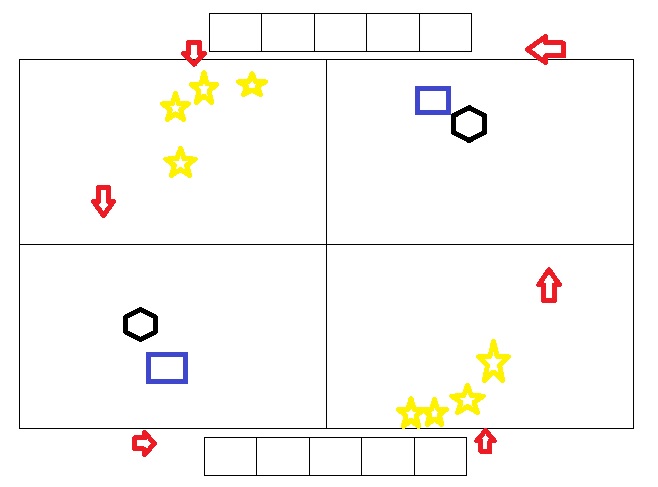
Basic exercise:
- Trainer throws the ball, player catches the ball and puts it in the cart.
- Then the player goes to the ladder, goes through it, and joins the next line.
Differentiation/Expansion:
- Throw difficult balls (left and right, front and back).
- Play underhand for themselves and catch.
- Two players get ready next to each other and have to call let go.
- A setupper is added who has to catch the underhand ball.
- An attacker is added who has to play the setupper's ball over the net.
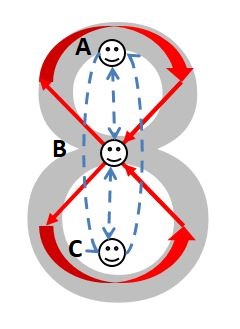
- Make trios
- Each trio has a ball.
- Player in the middle keeps running an 8. Every time this player comes in the middle, a ball is thrown:
- A throws (or plays overarm) the ball to B (in the middle)
- B throws the ball underhand back to A and then runs around A until he is back in the middle.
- Meanwhile, A plays the ball to C
- C returns the ball overarm to B.
- B plays the ball underhand back to C and then runs around C until he is back in the middle.
- Enz.
- after 2-3 minutes the player in the middle is changed.
Variation:
- To make it simpler, player A and C can throw instead of playing overarm. Could be underhand throwing/catching or overarm throwing/catching.
- To practice standing still when playing/throwing, player B can throw and catch underhand.
- The team is divided in 2 groups.
- Place a group on both sides of the net.
- 1 side will serve, the other side positions 3 passers
- They try to pass the ball high and this has to be caught on their own side.
- Servers take turns.
- A new passer will enter the field to replace the one who has caught the ball.
2 They play until 10 points. The servers score a point if the ball is not caught. The passers get a point if it is caught. Incorrect service does not count. After a round, they switch sides.deround with 2 passers instead of 3.
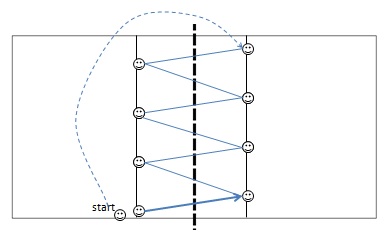
Divide over 3m line. Throw ball in zig-zag pattern and follow. See picture.
Later, play underhand, only overarm. One side of the net underhand, other side overarm.
Goal:
Improving the pass by positioning the shoulders in the playing direction
Pay close attention in exercises:
- Pass has to be high so player can catch ball 'overarm'.
- Pass to the right, right foot forward
- Pass to the left, left foot forward
- 'Eyes' of the shoulders in playing direction
The exercise:
- trios with 1 ball
- 1 an 2 are next to each other, not too close to the net.
- 3 is opposite 1, in the back of the field.
- 1 throws straight to 3, and 3 throws diagonally to 2.
- 2 catches and throws straight to 3, and 3 throws diagonally to 1.
- 3 keeps moving.
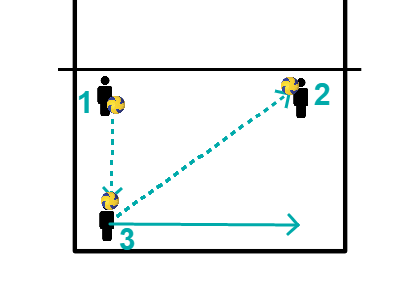
Service pass training for 4 to 12 persons
4 persons:
2 servers on the service spot .
1 passer
1 catcher
(static) Server serves, passer passes the ball to catcher, catcher catches the ball and rolls it back to the server.
(dynamic) same as static, but then the involved player walks after the ball. (server becomes passer, passer becomes catcher, etc.)
6 persons.
2 servers
3 passers
1 catcher
(Static) see four persons
(dynamic) server serves the ball and walks after his/her ball.
Passer passes the ball to catcher. The most right player becomes catcher
Server moves in from the left. Catcher becomes server. If this does not work, 1 passer becomes reserve.
- 1 serve, pass to S
- S sets up at 3 meters to one of the passers
- idem other side
- make rally
- serve from the side where the ball hits the ground
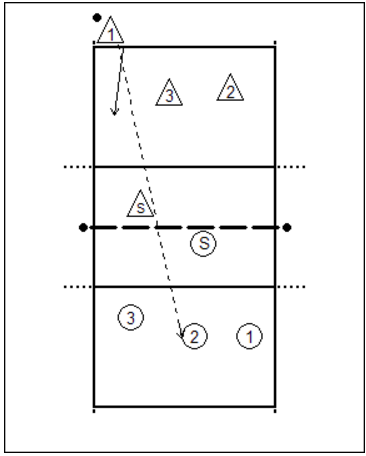

Moving as long as you can is for me the moment the attacker is about to hit the ball. At that moment the defender makes a split step and you make sure the focus of your body is being brought forward. So do not move backwards when the ball is hit, because your focus point is behind you and you will be too late to defend the ball before you. If the ball is defended, finish rally. |
- A serves to B.
- B passes the ball to the playmaker, who then plays a high ball in the back field.
- B defends this ball back to the playmaker, which gives a set up for A.
- A attacks to this set up.
After the attack, A takes the place of B, and B will be reserve. The playmaker remains.
The outside attackers use one playmaker and the left side of the field. The centre attackers and the diagonal attackers use the right side with a different playmaker.
Expansion:
- After the service, A takes a second ball.
- After the attack of B, A throws this ball into the field.
- B plays this ball to the playmaker, the playmaker gives a set up
- B attacks again.
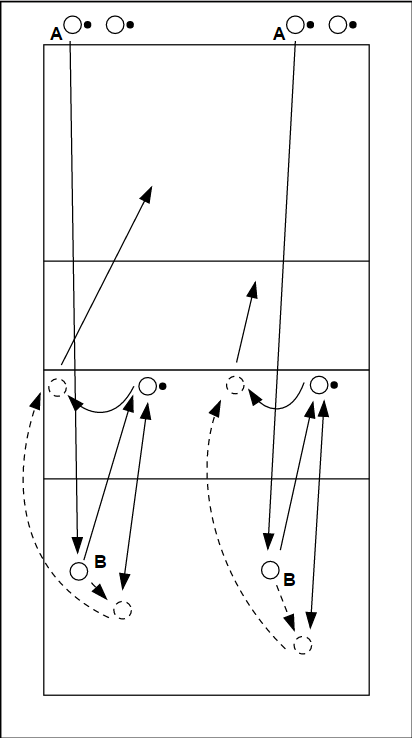
Pass and overarm exercise
- Player A and A1 have the ball.
- This player throws the ball to player B/B1
- Player B/B1 passes the ball back 'perfectly'
- Player A/A1 then plays the ball in the basket.
- Player A/A1 picks up the ball and joins the back of the line. You follow your ball
The tempo is automatic and can be increased. Make it harder by letting player B pass elsewhere, so player A has aim for the basket. Other option: Player A throws to a more difficult spot in the field.
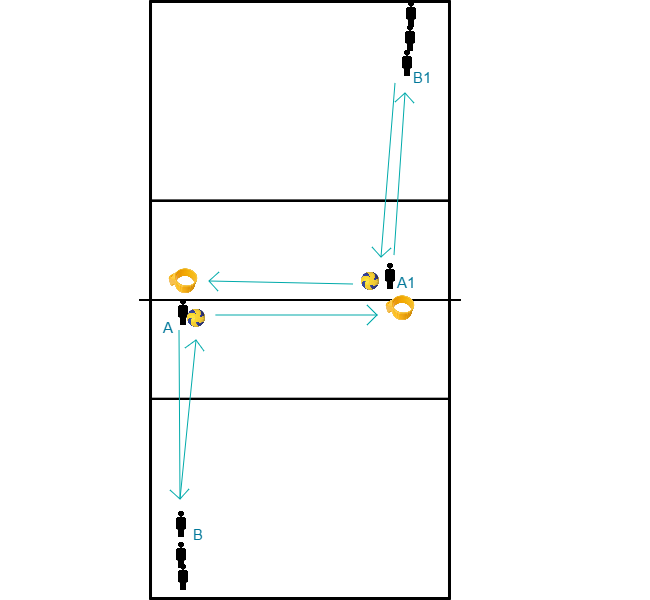

| If you put pressure on the opponent with your service and attack, the balls easily get over the net. It is a must to process these balls properly and (quickly) set up another attack. Precision is of the highest importance. The responsibilities have to be clear and taken by the players. It has to be clear for whom the easy ball is and who passes it. The place to which the ball is passed must also be clear. The speed of the rally pass is also of importance. Particularly when the playmaker is forward, you can pass the ball quicker to the net. Closer to the net, you pass the ball a bit higher, so everybody has time to prepare for the attack. The exercise: Coach throws ball in to the six. They build up an attack The six have to score from the rally pass. The four have to prevent this by blocking the ball and defend. When the 6 have 5 points, change. score keeping:
|
Estimate ball trajectory, shuffle, stand still, shoulders correctly, and pass properly.
- 3 players are at the net/ 3 meter line.
- 1 catcher
- Trainer hits the ball
- players shuffle backwards and pass to 2/3 players
- catcher catches and puts ball in box.
- passer to catcher
- empty space is filled







